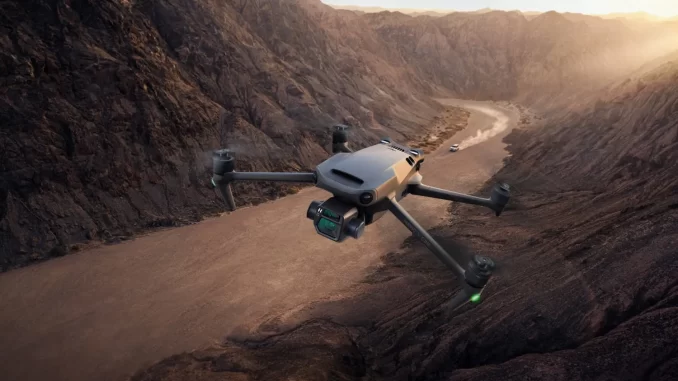
For decades, military developments have in most cases been far ahead of their civilian counterparts. There are many examples of technologies that emerged at the risk of war that later, adapted to civilian uses, have led to enormous advances and revolutionized the lives of ordinary people. However, there are many fewer occasions in which the opposite has occurred. For a few years now, however, there has been an interesting change in this situation, motivated by massive investment in civil R&D as a tool to maintain competitiveness, which is leading to many everyday products and solutions being subsequently adapted for use. military use; a real revolution. The Spanish defense industry, in need of funds to pay for new research and development programs, has been looking for a lifeline in dual technologies for some time and an opportunity to access financing, both national and community, that would otherwise be prohibited to it.
War, despite the misfortunes it entails, has been behind a good number - if not most - of the progress that has changed the lives of many humans for the better. From a multitude of medical techniques to the Internet itself, there are many advances that have a military or defense-related origin. However, this phenomenon has been neither universal nor a historical constant.[1]. In reality, technology was always on par with the societies that generated it and used by the military, who always tried to borrow those most promising discoveries and inventions to achieve better performance on the battlefield. Furthermore, it could be considered, logically, that the distinction between military and civil technologies is in many cases artificial, since technologies are one thing and the applications derived from them are another. However, it is impossible not to think that something is changing in recent years and that we are entering a somewhat unknown era.
In Universal History, where Military Revolutions -if they exist- would be counted on the fingers of one hand[2], civil and military technical progress, the social changes that motivated and accompanied them, as well as the political and economic changes related to them, were in all cases closely linked, without it being easy to determine to what extent some preceded others or whether There was a causal relationship between them. This was the case at least until the Second World War, at which time military technology absolutely took the lead over civil technology, motivating in a very short time an enormous leap that led to ocean-going submarines, jet planes, and modern logistics. (standardized) and even atomic weapons. Since then, the United States led an arms race with the Soviet Union in which most of the technology companies were involved, which led in one way or another to the US Department of Defense or its Soviet counterpart (along with related ministries, such as Atomic Energy) would first take advantage of the fruits of each project. It is the era par excellence in which the Military-Industrial Complex monopolized unprecedented power, coming to have a significant influence on the decisions of some presidential cabinets, hence, among others, Eisenhower's famous warning upon his departure from the White House in 1961[3].
This situation, although it spread after the end of the Cold War, was soon overcome due to two related factors: the dynamism of civil industry, which was giving birth to a new industrial revolution on the basis of many originally military advances and; the generalized cut in defense investment, the so-called “peace dividends”, which were used in part, delving into the previous phenomenon, to finance civilian research. Since then, given that American military, economic and technological superiority guaranteed both the unipolar order and strategic stability, investment in defense being therefore secondary for many States - especially in old Europe - civil industry has been leading the immense most of the great advances. These have largely been related to computing and communications, although also to mobility, energy or space. On the other hand, now that we are entering an era of great power competition, with actors such as Russia and China openly questioning the post-World War II rules-based international order, the confrontation between powers is increasingly waged at the technological, commercial and economic and not only in the military. This means, on the one hand, that even in times of war like the current one, with an open conflict in Ukraine that has already motivated increases in the defense budgets of several States, investment in defense remains in general terms well below what common in the Cold War. On the other hand, states and also international organizations such as the European Union design security strategies that try to be holistic, trying to go beyond the purely military, which predicts that the funds available to the industries in the sector, even if they are going to grow, never return to pre-1989 levels, barring catastrophe. And yet, each new development is, as a rule, capital intensive, which puts the defense sector in a difficult situation.
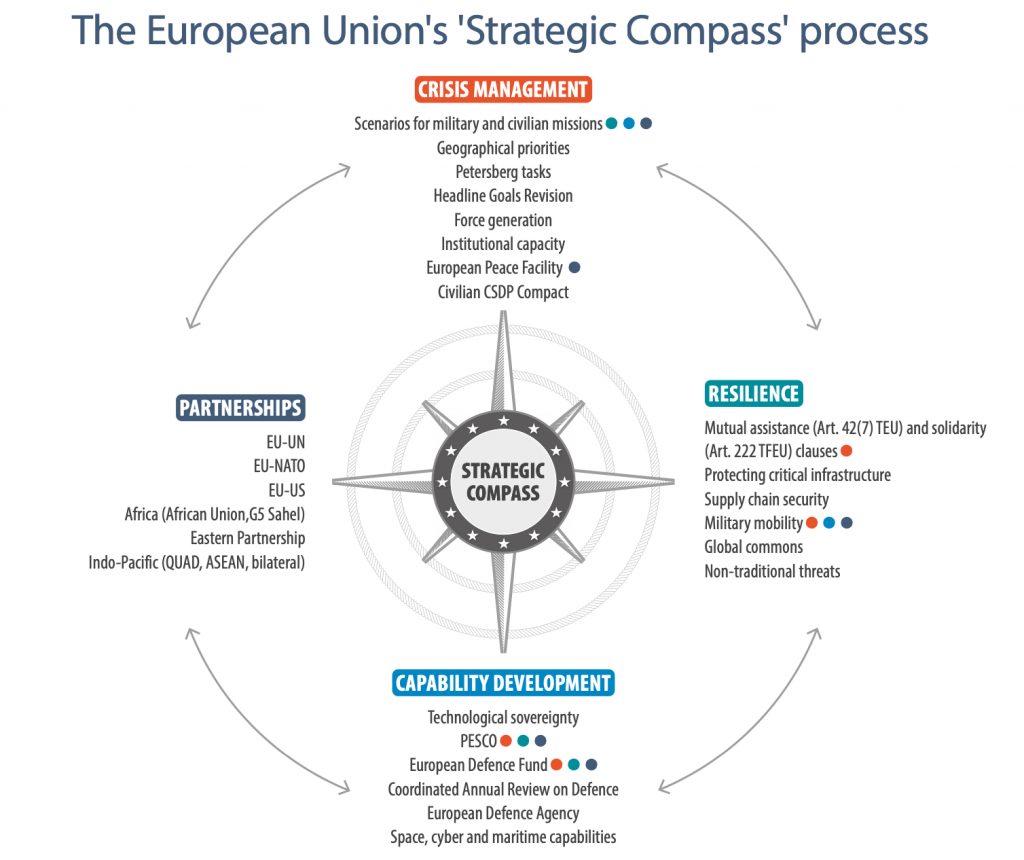
A resource problem
According to the Spanish Ministry of Defense, “The Defense Economic Sector is made up of a group of companies whose main link is the provision of goods and services to the Ministry of Defense.”[4]. To this they add, in the Defense Technology and Innovation Strategy 2020, that: “The defense sector is a cutting-edge and very demanding technological sector that requires the continuous development of R&D&I activities in order to be competitive.”[5]. In the case of our country, we are talking about 543 companies registered in the DGAM registry, totaling sales of 6.654 million euros in 2020, of which 1.199 million corresponded to acquisitions by the Ministry of Defense itself and 5.290 million to exports.[6]. These are impressive figures, especially if we take into account that the sector generates more than 20.000 direct jobs in Spain, many of which are among the best paid that exist and that the driving power of these industries is enormous.
Despite this, these numbers are clearly insufficient to compete with guarantees at an international level, especially against companies such as the United States and, increasingly, Chinese, with resources far superior, even in unit terms, to those of the entire sector. Spanish defense as a whole. To give an example, Lockheed Martin had a turnover of $2021 million in 64.458[7] (61.060 million euros as of December 13) in defense-related sales, thus multiplying the income of the Spanish defense industry as a whole by 9. It is therefore easy to understand that our companies, despite their specialization and being focused abroad, in search of markets that make up for the lack of investments of our Ministry of Defense, find it very difficult to measure themselves against the foreign giants. Furthermore, it must be taken into account that, as we explained at the time in the Journal of International Security Studies (RESI)[8], we are talking about a sector that in general terms is intensive in terms of the use of monetary resources destined for R&D, something that is far from being a priority in Spain despite the foreseeable increases in terms of investment in Defense. An enormous investment is therefore required to achieve significant progress in any of them, which makes it unfeasible for a medium power like Spain to be self-sufficient not only in all of these, but very possibly in any of them individually.
The Ministry of Defense, aware of the limitations of the Spanish industrial fabric to keep pace with advances, carries out, through the DGAM, a series of R&D initiatives such as the COINCIDENTE program, aimed at “taking advantage of technologies of a civil nature developed within the scope of the National R&D Plan to incorporate innovative technological solutions of interest to the Ministry of Defense, thus promoting the industrial, scientific and technological fabric dedicated to defense"[9]. It also finances National R&D Programs, currently with 16 of them underway. However, the amount of these initiatives and other comparable ones is so limited that it will hardly be able to serve to promote the design and production of truly competitive systems. What's more, to give us an idea of the situation, in the 2022 Defense Budget, credits worth 35.73 million euros have been allocated for technological innovation, a ridiculous figure despite the fact that it has grown by 17,39% from 2021[10]. In addition, there is another added problem and it is the marked finalist nature of the investment in R&D of the Ministry of Defense, whose stated objective is “to contribute to providing the FAS with weapons systems and equipment with the appropriate technological level.”[11], which seems impossible with these figures. This, in turn, requires promoting synergies between Spanish companies, through the signing of collaboration agreements or the creation of joint ventures, or to resort abroad, the most obvious example being Spanish participation in PESCO, a mechanism that has the advantage that “it leaves national sovereignty intact and does not affect the specific nature of the security and defense policy of certain Member States ”[12] and the European Defense Fund.
That said, and although there are notable exceptions, the Spanish defense industry as a whole does not seem to be in a position to compete in the long term, nor to provide the Armed Forces with the necessary materials to guarantee the fulfillment of their functions. This should force us to think if we are not missing the mark when it comes to focusing ministerial investments, trying to maintain a defense industrial fabric that is too broad, but made up of very small companies with little capacity to innovate, not for lack of vocation - rather the opposite - but to gather the necessary means. Above all, it forces us to think about possible solutions, some of which are not at all foreign to the Ministry, even if they are not decisively implemented later. Among the escape routes to this apparently unsolvable problem, there are some that we have already explored in previous documents.[13]:
- Favoring the integration of many small and medium-sized companies into larger ones - taking into account, of course, the lessons learned after the sales of Santa Bárbara Sistemas to General Dynamics and the integration of CASA into EADS - and allowing them to thereby gain the sufficient volume to be able to compete in a world of giants or, at least, ensure its survival;
- Focusing the resources currently divided among the entire sector on those companies truly critical to national security and;
- In relation to the previous point, evaluating whether all companies in the defense sector - although not only - are equally valuable or if there are specific characteristics to which we must pay greater attention. Let us not forget that in the world to come, uncertain and in the face of new conflicts, difficult to advance based on previous ones, the most important capacity is not to design this or that weapon, system or platform, but to be able to respond in record time to constantly changing needs.
However, it is possible that even the above may not be sufficient by itself to guarantee the future of the sector in an increasingly competitive world and in which each new development implies mobilizing enormous amounts of resources, whether the Laws of Augustine are applied or not.[14]. This brings us to another option that our companies have been using for some time and that will foreseeably gain in importance in the coming years: the commitment to dual technologies, which allow them not only to open up to new markets, but also to finance future developments that could be adapted for military use.
It is not a new phenomenon - many war industries have converted to the civilian sector once a conflict has ended and vice versa - but it is increasingly common. Furthermore, it is one of the few ways that defense sector industries in the West have if they intend to compete in conditions analogous to those of the Chinese industry, where the relationship between the civil and the military and the public and the private is almost non-existent, which allows its technological conglomerates to always advance hand in hand with the interest of their defense.
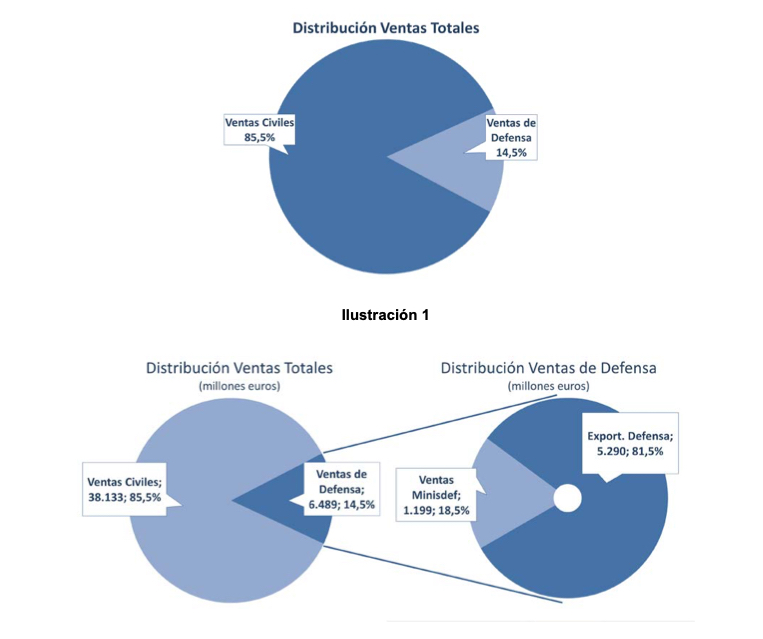
Dual technologies, COTS, MOTS, GOTS and NOTS
Before dealing with specific cases, it is worth making a small clarification, since in many cases dual technologies are usually assimilated to COTS, GOTS, MOTS or NOTS components. However, they are not exactly the same, although they are related.
Dual technologies are, at least officially, those that find applications both in the field of Defense and Security and in the civil sector.[15]. In reality, the concept itself gives rise to confusion, since there are not several technologies (civil, military, dual), but one, and applications are developed based on this.[16]. That is to say, any technology may have been developed for civil functions and later be discovered to have a military application and vice versa. In many cases, knowing in advance that a certain product or the technology associated with it will have application in both worlds, this is influenced from the design phase. However, this does not always occur, but sometimes it is companies in the defense sector or armies that take technological advances, mature or not, and adapt them to their needs.
A good example of the above is found in the Ukrainian war. As we know, it has starred, among others[17], due to the generalization in the use of commercial drones both for observation and reconnaissance and for attack - with the consequent modifications -, damage assessment or correction of artillery fire, among other functions[18]. Although the country had a buoyant military drone industry - on its scale - born since 2014, they have been totally eclipsed by the massive use of civilian models, in many cases brought to the front as donations, on particular occasions thanks to the through crowdfunding. It is nothing more than one of the faces of a more complex phenomenon, which began in the 90s, with the generalization of the use of consumer computing products applied to the Armed Forces and has deepened since then in a thousand ways.
Another example of this is the use of commercial software, even open source, to manage large military systems. The same with many of the hardware components, which are increasingly purchased on the civilian market, thus avoiding part of the problems associated with captive systems. Open architectures allow systems to be updated more often, benefit from greater compatibility with other systems that use the same programs and components and, of course, reduce development, acquisition and life cycle costs. You only have to investigate the architecture of systems as complex as the Integrated Combat System of our submarines or frigates to know that they have adopted this type of solutions to a large extent, despite the fact that some of the solutions continue to be exclusive to their manufacturers. The same could be said of many military simulators. Although the most elaborate ones are almost exact replicas of the original, capable of moving in three dimensions and reproducing each reaction of the aircraft or vehicle to be simulated, this is not always the case. For many other things, simple personal computers are used, not even too powerful, linked to models that, for very little money, allow an infantryman or even entire units to train alone or in a network.
Having said all the above, it is convenient to differentiate between dual technologies, in generic terms and some commonly used acronyms such as:
- COTS (Commercial-Off-The-Shelf) They are those that remain “as is” even within military systems or platforms. This means that the hardware is a standard product that already exists and is commercially available, having been designed to be easily installed and interact with other components that are part of the system. Some of the benefits of using COTS products are lower costs, reduced development time, or the lower life cycle cost that comes from using easily available and updated products. Examples of this could be some components used to guide drones, optical systems, batteries or even 3D printers used for the production of certain parts.
- MOTS (Military or Modifiable Off-The-Shelf): It is, neither more nor less, than a COTS product whose source code can be modified, being customized by the supplier or the end user to meet the desired requirements. This is, for example, what happens with many combat systems, which use commercial components and source code, but which are adapted to meet a series of specifications derived from the use to which they are going to be given. The same could be said of the software and electronic components of many other military systems, from optronics to shooting systems, such as the RWS. The biggest problem with this type of solutions is that, when the source code is not under the control of governments, and therefore is not exclusive, in principle it is easier for security flaws to occur.
- GOTS (Government Off-The-Shelf): We talk about this type of products, when they are developed according to government specifications. It is, to explain it simply, a set of standards that, if met by a product, even if it is commercial, can be used for use by government agencies of this or that State, without having to worry about anything other than its acquisition, since the compatibility is total.

Dual technologies under development by the Spanish defense industry
As we have explained, the mere concept of dual technology is questionable, since in a way they all are, as long as they are given both civil and military applications. That said, practically all the most promising technologies - disruptive or not -, such as those associated with space research, energy, telecommunications or the development of new materials, have dual uses, at least potentially.
However, there are some that are more likely to go into production in the short or medium term, due to various factors, which is why many companies are currently working on them, with several notable cases in Spain ranging from guidance technologies to optronics. and from Artificial Intelligence to smart manufacturing. Among these, it is worth highlighting some examples that have already served to illuminate different products, in some cases of success.
Anti-drone systems
The generalization in the use of drones for all types of tasks entails a curious derivative, which is the need to install anti-drone systems in all types of places and in any situation that we can imagine. At the moment it is not too common, although for example the Civil Guard or the National Police in Spain already use them, to see anti-drone systems on the street or in football stadiums. However, as ordinary citizens, but also terrorist or criminal organizations have more and more access to certain technologies, it will be all the more necessary to install anti-drone systems in public buildings and places where large concentrations of people occur.
Thus, commercial ports, hydrocarbon refining or storage facilities, regasification plants, nuclear power plants, soccer stadiums and many others, will sooner or later need systems of this type in fixed installations or, at least, the possibility of them being deployed in certain situations. Just think about what could happen in the event that someone, even a “lone wolf”, decided to attack one of these devices in a massive event, in which more deaths could potentially occur due to panic and the subsequent stampede. than for the attack itself.
Therefore, many of the solutions originally developed for the Armed Forces have been adapted for what was previously called “Homeland Security”. What's more, as time goes by, manufacturers are increasingly betting on developing more capable and competitive models, leaving aside traditional military specifications - such as ruggedization - to opt for dual use from the first moment. Where there is some difference is in the type of anti-drone systems that are used in both areas, since although in the Armed Forces it is normal to resort to systems hard kill -generally kinetic-, in the civil world it is much more common to find systems soft kill which not only go more unnoticed, but are less likely to cause collateral damage of any kind.
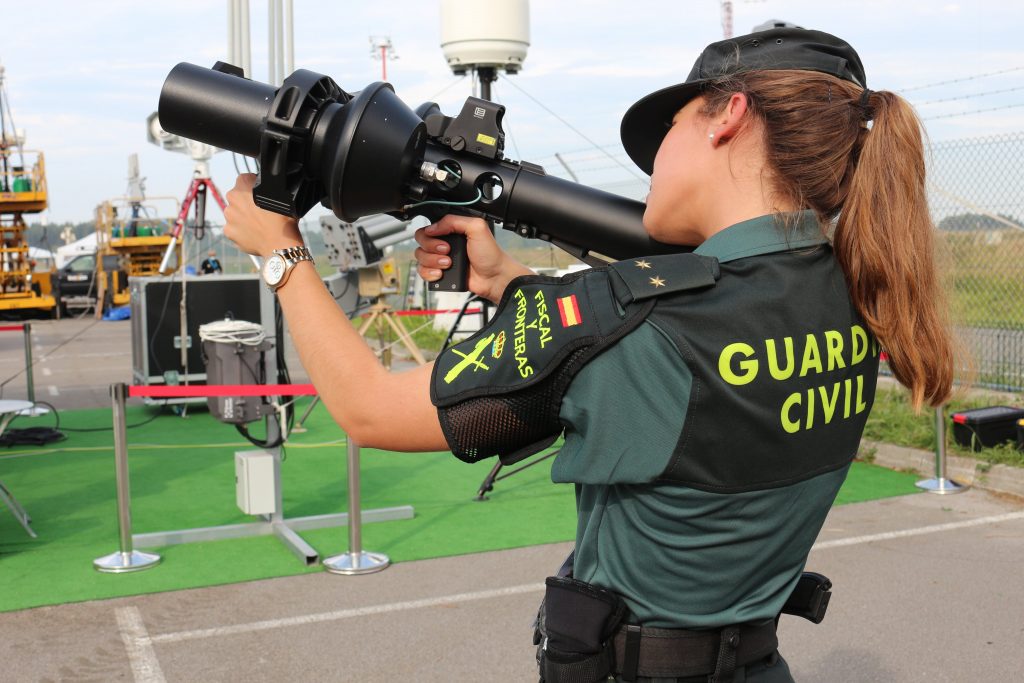
Border/access control
Another field in which interesting advances are being made is that of access control, which combines recognition technologies (software) with cutting-edge optronics mounted both in fixed installations and on vehicles and increasingly more drones, whether aerial, terrestrial or naval. . These types of systems are used both for the control of border lines, where fixed optronic systems are installed on posts or surveillance towers, and for the detection, identification and tracking of drug boats, boats or anything else, mounted on patrol boats. A recent example can be found in the contract assigned by the SIVE (Integrated External Surveillance System) of the Civil Guard to Escribano Mechanical & Engineering, worth 19 million euros, on September 9[19]. It is not even the first, since a few months ago, in November 2021, they had received another contract to provide the Benemérita patrol boats with six OTEOS, to add to the nine acquired by the Customs Surveillance Service a month before.
It's not by chance. The OTEOS (Observation and Tracking Electro-Optical System) is an electro-optical observation and tracking system, specially designed for installation in fixed positions or integrated into land or naval platforms and vehicles. It is a stabilized and modular platform equipped with the latest technology available on the market in optronic sensors in the visible and infrared bands to increase its capacity in terms of detection range, high definition resolution for identification and automatic tracking of targets. Additionally, its modular design and open architecture allow for easy installation and maintenance and integration with external sensors.[20]. It is therefore feasible not only to mount it on very different platforms or, as we have said, on fixed positions, but also to scale it to control large areas. In fact, by mounting them on the appropriate platforms, organizations such as the Civil Guard or the European Border and Coast Guard Agency (Frontex) could monitor in real time and with greater precision the areas of passage for immigrants both on land and at sea. The latter would also increase the possibilities of rescue, thus reducing the number of people who drown each year in the Mediterranean or in transit to the Canary Islands.
What's more, although these are possibilities still being studied, on paper the system could also be provided with specific facial recognition software, which would allow the location and identification of specific people, among many other possibilities. Elaborating on this, beyond searching for people, these systems can also be programmed to locate certain objects, such as the silhouette of a drug boat. Of course, always understanding that no matter how automated it becomes, we would always talk about systems human-on-the-loop[21], in which there would be a human being controlling not the identification of the objective, but any decision regarding it, such as notifying the State Security Forces and Corps (FCSE) or whatever is considered necessary.
Beyond borders, the same technologies should make it possible to do the same on a smaller scale in sensitive facilities such as commercial ports or naval bases, hydrocarbon storage tanks, and even monitoring the layout of gas and oil pipelines or any critical infrastructure that we can. imagine.

Environmental risks
Another field in which dual technologies play an increasing role is environmental care. One only has to think about observation and reconnaissance satellites, with a clear dual application and which, even in the case of those intended for the detection of forest fires, have an obvious military use. In this sense, the war in Ukraine is a great example of the abundant and useful information that can be obtained through civilian OSINT tools such as NASA's FIRMS system.[22], which in many cases allows us to follow the areas in which the bombings are most intense. Same for ESA Sentinels.[23] and for commercial satellite photography systems that offer their products at increasingly affordable prices. However, satellites are not the only way to control problems such as forest fires, illegal dumping and many others that affect nature. Especially in a country like Spain in which large areas of land on the two plateaus are increasingly depopulated and, as a consequence, worse monitored.
In relation to this, the Civil Guard, although it is not the only organization affected, has growing problems when it comes to covering, with its limited troops, entire regions in which hardly anyone lives and, therefore, do not have police stations or agents. enough. Furthermore, far from the lack of population mitigating the appearance of possible problems, it aggravates them in every way: 1) the forests are no longer maintained, as are the firebreaks that cross them; Power lines and many facilities are left more unprotected against cable theft; 3) illegal landfills appear due to the lack of effective police presence; 4) illicit discharges occur, etc. A separate case is that of the crops of all those plants such as marijuana, coca or poppy, from which drugs are extracted. Perhaps it is not the biggest problem for Spain, but it is a thorny issue in many of the countries with which we maintain close contact, from Latin America to North Africa. The dual systems that we have talked about would allow the detection of this type of crops from the air - as long as they are outdoors, obviously -, making their eradication and the prosecution of those responsible possible.
Without having to resort to expensive satellites, of which Spain is not exactly well served, there are plausible options such as the use of drones to patrol vast areas. Specifically, using a swarm of aerial drones with one or two dozen coordinated elements would allow a large area to be covered in detail, minimizing detection times. This, which is useful in war, is also useful in peace, for example, when locating victims of possible natural disasters, outbreaks of forest fires, spills in the sea, etc. By not depending on a single device being in a position to locate whatever is being sought, but rather that several would do it at the same time, the deadlines - sometimes critical - would be reduced.
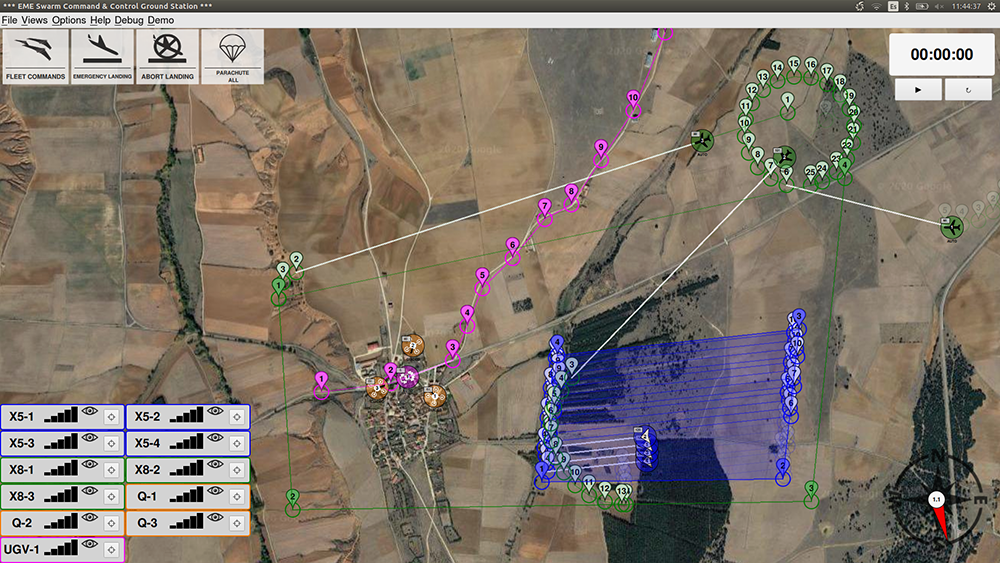
Predictive maintenance / interactive learning
Predictive maintenance, as we explained a few months ago[24], arises from the need to maintain high operability in means that, due to their cost and relatively small number, were not - and are not - dispensable, such as combat aircraft, warships, battle and armored tanks or the helicopters. In the past, vehicles were in operation until they broke down, in which case corrective maintenance tasks were carried out. The accidents that were caused, the associated expenses and the uncertainty of availability to which these practices led were unacceptable, so a series of periodic review plans were designed for the teams, which sought to achieve greater reliability and avoid the most serious consequences, both for people and vehicles. When we talk about a single vehicle, in the case of which a family may own, acting correctively, after the fact, may be feasible. On the contrary, when what we have to manage is a fleet with dozens, hundreds or even thousands of these, it is too onerous. Companies cannot afford this type of luxuries, since this waste of resources would cause them to cease to be profitable or to not be able to continue offering their services due to an accumulation of breakdowns. Therefore, the need arose to monitor vehicles to know their status while they are in service, performing the necessary maintenance tasks when there is clear evidence of degradation in their operating parameters.
In addition, individualized management of the vehicles was imposed, with each one having individualized management of the preventive maintenance tasks that correspond to it. This is so, since no manager of a bus fleet would send all of them at the same time to undergo in-depth inspections, temporarily being left without a fleet. On the contrary, knowing each person's situation, you can decide what time is most convenient to carry out this or that maintenance task and plan accordingly. This allows for great savings without reducing operability and, translated into the economy of scale that comes with fleets of hundreds of vehicles, such as those owned by the Armed Forces, but also many companies, allows for great savings to be achieved.
It is therefore a completely dual technology, since the basic problems that the Armed Forces and passenger or merchandise transportation companies must face - regardless of the means, be it air, sea or land - are substantially the same. Hence, the developments coming from the defense industry, forced to deal with more complex and sensitive systems in many cases, have a direct application in the civilian world and hence also why companies like EM&E, which we already talked about, are looking for expand beyond the military world, taking its predictive maintenance developments to other areas.
In relation to the above, it is necessary to talk about “digital twins”, virtual copies of the platforms that allow an engineer from company To do this, said engineer has control over each part of the vehicle or system at all times, viewing all the relevant data on his computer screen and maintaining contact with the personnel on the ground so that everyone can carry out the tasks. more complex maintenance. Examples of this can be found in the future F-110s, but also in the Guardian 30 towers of the 8×8 VCRs and increasingly in more and more systems.[25].
Finally, to close with this subsection and halfway between this and the next, it is time to make a reference to interactive learning, which using augmented reality, VR glasses and QR codes allows the operators of this or that system to access it comfortably and accessible to all its technical documentation, the list of maintenance tasks and the steps that must be taken to implement them.
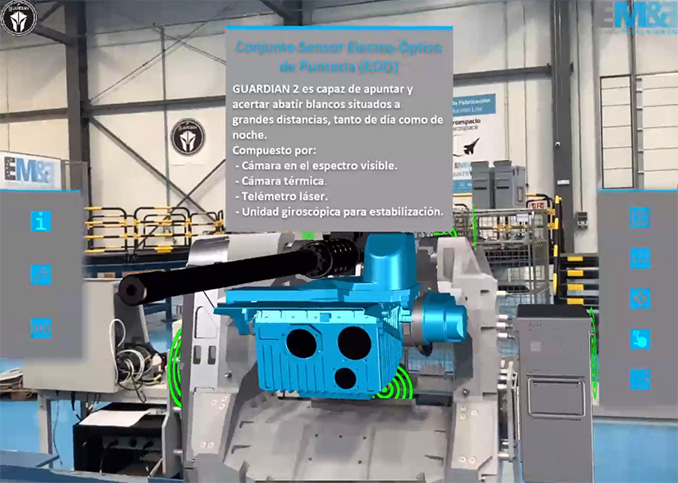
Military simulation/modeling
Military simulation is the representation of either a real system or a set of situations through computer and telecommunications means, which allow units to be instructed, trained and evaluated, with a lower cost, in time and money, a better performance. superior, and similar efficiency to that which would be obtained with the execution of all the activities associated with instruction and training[26]. In reality, it hardly differs from civil simulation, that intended, for example, to train aviation pilots or, increasingly, drivers of heavy vehicles, racing drivers, crane operators, industrial machinery and many other things. If anything, in the degree of complexity of some scenarios or in the subsystems that must be simulated to offer certain training, as is the case with combat pilots.
Among the reasons why simulators are increasingly being chosen to the detriment of real vehicles or systems, it is worth mentioning: 1) The drastic reduction of resources allocated to Defense in recent decades, including allocations for training; 2) the increase in the cost of military systems, including the life cycle and, therefore, each hour of use; 3) the increasingly reduced numbers of these, which force us to be careful both with the hours of use and with the possibility of losing one of them by accident; 4) the possibilities that simulation offers when creating scenarios and situations that would not be replicable on a real training field; 5) respect for the environment, which may seem secondary, but increasingly limits the possibilities of the military in some aspects; 6) the increasingly pronounced complexity of some weapons materials and systems and last but not least; 7) safety, since many exercises could not be carried out with real vehicles, platforms or systems without posing a serious risk to the student and in many cases also to the instructors.
Having said all the above, it is not surprising that simulation is also increasingly widespread in the civil field and that some companies in the defense sector are those that are contributing the most to this field, both in the physical part (construction of equipment simulation), as well as in relation to the software that allows them to be moved and, of course, in everything related to scenario modeling. Regarding the latter, the applications are endless, especially now that we are experiencing a “boom” in virtual reality and there are even those who think in terms of “metaverses”.
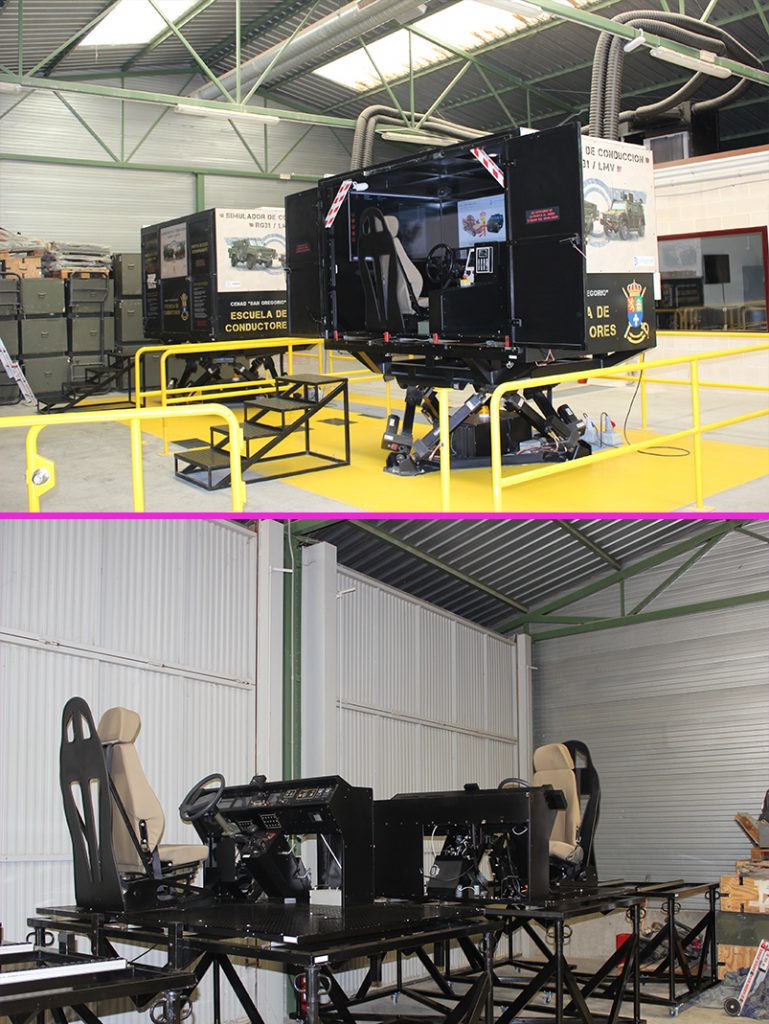
The true duality
When we talk about dual technologies, we generally always refer to those that can be used by both civilians and military, but with a certain finalist sense, such as those that we have been listing throughout the article. However, there are other types that are even more important and that are, perhaps, the ones that should be most careful in view of the paths that the War is taking.[27]. One only has to think about the war in Ukraine, increasingly a war of attrition but, despite this or perhaps because of it, given the stagnation, with a very high rate of iteration, a consequence of trying one after another new solutions that each introduce one of them small incremental improvements. A war in which the ability to respond quickly to new needs, manufacturing in a few days or weeks large quantities of everything that demonstrates better performance, could give the advantage to any of the opponents, causing the opponent's exhaustion or, at the same time, less, returning dynamism to the battlefield.
The problem in this case is that we rarely identify the technologies that would make the latter possible, with dual technologies. That is to say, It is easy to see a DJI “Mavic” drone and understand that it can be used for military or civil purposes. What is not so simple is to think that the facilities that manufacture it and the technologies used in the production process could also have a dual use, since we usually keep the final product. We are referring to machine tools and specifically to all those technologies related to manufacturing, which are part of what is called “Industrial Revolution 4.0”.[28] and that are characterized by their enormous versatility and efficiency. Among these, we could mention robotics, computerized cutting, additive manufacturing or high precision machining. And although we always talk about battle tanks, airplanes, warships, howitzers or rifles, in the face of the defense of a country and today, it is perhaps more important to have the ability to quickly adapt production lines to new gadgets, than having a large stock of any of them or, worse still, with stagnant companies capable of only producing one type of systems, but with little "waist" to adapt to new needs. It is something that we have seen clearly with the pandemic caused by the COVID-19 coronavirus, to which only a handful of companies with EM&E at the helm knew how to respond and about what we have already talked about previously on these pages[29].
In a world in which Defense is no longer an independent entity that follows its own path, but is part of the much broader concept of Security, it is worth asking if the most important aspect of what is called “Strategic Autonomy” It will not be to be able, with our own resources, to satisfy very disparate strategic needs. In this sense, we should reconsider which companies are truly important for Security and Defense in Spain and whether they do not require special protection.
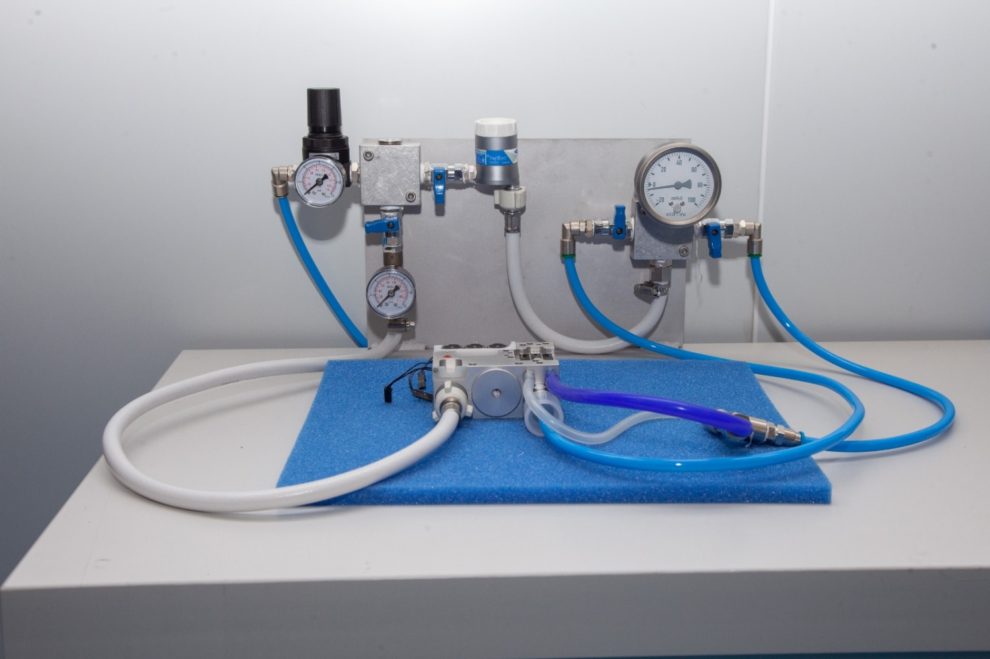
final thoughts
Spain must abandon many of the inertias it carries and many of the prejudices related to innovation in defense matters. The only important thing, really, is to generate new ideas from which the Defense can benefit and to do so - at least in many segments - it is indifferent whether the company that has created them has done so thinking of selling them to the Army, to Civil Protection or to a chain. of supermarkets. At a time in which military technology is no longer ahead of the civil sector and in which there is a real boiling over in certain types of technologies, the most logical thing is to give free rein to its civil development so that, when the In this case, the military can choose how to best meet its needs from a wide range of options. Also be very clear about which technologies and capabilities - in reference to smart manufacturing - are really important and deserve to have maximum state support.
It is also necessary to change the current finalist orientation for another that encourages basic technologies. This finalist orientation is dangerous right now, because in a moment of radical change, if one makes the wrong bet, the inertia generated (case of very long-term and very expensive programs such as FCAS)[30] They can prevent us from responding in time to the new conditions on the battlefield.
To do this, perhaps we would have to move towards an open innovation model that leaves aside the distinction between civil and military and that can benefit from European and national research programs, thus making up for the chronic lack of funds of our Ministry of Defense, something that It is not going to change even with the foreseeable budget increases. As Félix Arteaga explains[31]:
“The Next Generation EU fund will mean direct transfers for Spain that are estimated at €72.700 billion plus the same amount in credits if requested. Its 750.000 million euros are distributed between the Recovery and Resilience Facility (672.500 of which 360.000 in loans and 312.500 in subsidies), REACT-EU (47.500), Horizon Europe (5.000), InvestEU (5.600), rural development (7.500 ), Just Transition Fund (10.000) and rescEU (1.900)”.
What is really important is to generate a sustained flow of new ideas from which Defense can benefit and to do so, in many segments it is indifferent whether the company that has given birth to them has done so thinking of selling them to the Army, to Civil Protection or to a supermarket chain. At a time in which military technology is no longer ahead of the civil sector and in which there is a real boiling over in certain types of technologies, the most logical thing is to give free rein to its civil development so that, when the In this case, the military can choose how to best meet its needs from a wide range of options.
Notes
[1] Roland, A. (February 27, 2009). War and Technology. Foreign Policy Research Institute. https://www.fpri.org/article/2009/02/war-and-technology/
[2] “Military Revolution” is a disputed term that has generated numerous debates without there being genuine agreement either on the concept itself, or on the number of these that have occurred throughout History. See Colom-Piella, G. (2008). Between Ares and Athena. The debate on the Revolution in Military Affairs. General Gutiérrez Mellado University Institute. https://iugm.es/wp-content/uploads/2016/07/Libro_Entre_ares.pdf
[3] President Dwight D. Eisenhower's speech (1961) on the “Military-Industrial Complex.”
https://avalon.law.yale.edu/20th_century/eisenhower001.asp
[4] Ministry of Defense (2010). Economic foundations of the defense industry market. Defense Industrial Policy Notebooks, 3. https://publicaciones.defensa.gob.es/media/downloadable/files/links/c/u/cuaderno_isdefe_03.pdf
[5] Ministry of Defense (2020). Technology and Innovation Strategy for Defense ETID – 2020. https://publicaciones.defensa.gob.es/estrategia-de-tecnologia-e-innovacion-para-la-defensa-etid-2020-libros-pdf.html
[6] Ministry of Defense (2020). The defense industry in Spain. Report – 2020. General Directorate of Armaments and Material, General Subdirectorate of Inspection, Regulation and Defense Industrial Strategy.
https://www.defensa.gob.es/Galerias/dgamdocs/Informe_Industria_Defensa_2020.pdf
[7] Defense News (n.d.). Top 100 for 2022. https://people.defensenews.com/top-100/
[8] Villanueva-López, C. (2021). The Spanish defense industry in the face of new conflicts: capabilities to contribute. Journal of International Security Studies, 7(2), 63-81. DOI: http://dx.doi.org/10.18847/1.14.4
[9] Technology and Innovation Portal of the Ministry of Defense (s.f.). Matching program. https://www.tecnologiaeinnovacion.defensa.gob.es/es-es/Presentacion/ImasD/Paginas/Coincidente.aspx
[10] Ministry of Defense (2022). Budget of the Ministry of Defense.
https://www.defensa.gob.es/Galerias/presupuestos/presupuesto-MINISDEF-2022.pdf
[11] Ministry of Defense (2020). Technology and Innovation Strategy for Defense ETID – 2020. https://publicaciones.defensa.gob.es/estrategia-de-tecnologia-e-innovacion-para-la-defensa-etid-2020-libros-pdf.html
[12] Cózar-Murillo, B. (2018). The launch of permanent structured cooperation: a new success in the security and defense of the European Union. Spanish Institute of Strategic Studies, Bie3: IEEE Bulletin, 10, 278-292. ISSN-e 2530-125X. https://www.ieee.es/Galerias/fichero/docs_opinion/2018/DIEEEO32-2018_Coop-Estrcut-Perman_UE_SegyDef_BeatrizCozar.pdf
[13] Villanueva-López, C. (2020), on. cit.
[14] Augustine Laws (May 12, 2021). In Wikipedia. https://en.wikipedia.org/w/index.php?title=Augustine%27s_laws&oldid=1022823402
[15] https://www.cdti.es/index.asp?MP=100&MS=893&MN=2
[16] Coloma, G. (2017). The efficiency of defense R&D financing in Spain: the COINCIDENTE program. [Master's Thesis]. General Gutiérrez Mellado University Institute.
[17] Pulido, G. (2022). The Ukrainian War and the Mosaic War. Armies, 39. https://www.revistaejercitos.com/2022/08/28/la-guerra-de-ucrania-y-la-guerra-mosaico/
[18] Villanueva-López, C. (2022). Long-range loitering munitions. The operational level as objective. Armies, 38. https://www.revistaejercitos.com/2022/07/18/municiones-merodeadoras-de-largo-alcance/
[19] Carrasco, B. (September 9, 2022). The Civil Guard commissions Escribano to fine-tune its boat and drug boat detection system. Infodefense. https://www.infodefensa.com/texto-diario/mostrar/3883177/guardia-civil-encarga-escribano-puesta-punto-sistema-deteccion-pateras-narcolanchas
[20] Villanueva-López, C. (2022). OTEOS and APOLLO. Armies, 38. https://www.revistaejercitos.com/2022/07/06/oteos-y-apolo/
[21] Villanueva-López, C. (2019). Autonomous weapons. A brief introduction. Armies, 11. https://www.revistaejercitos.com/2019/09/06/armas-autonomas/
[22] NASA (sf). Fire Information for Resource Management System (FIRMS). https://firms.modaps.eosdis.nasa.gov/map/
[23] Sentinel Online (n.d.). Technical Guide Overview. https://sentinels.copernicus.eu/web/sentinel/sentinel-technical-guides
[24] Vidal, E. (2021). Beyond predictive maintenance: EM&E's plans for the Guardian 30. Armies, 29.https://www.revistaejercitos.com/2021/10/31/mas-alla-del-mantenimiento-predictivo/
[25] Ibid.
[26] Fernández, F. P. (2018). Military simulation systems. Armies, 4. https://www.revistaejercitos.com/2018/09/25/sistemas-de-simulacion-militar/
[27] Do not confuse “War”, with a capital letter, understood as the “war phenomenon”, with a specific war.
[28] Ejercitos Magazine (December 14, 2020). “Bianchi, P. (2020). 4.0: The new industrial revolution. Editorial Alliance”. Armies.https://www.revistaejercitos.com/2020/12/14/4-0-la-nueva-revolucion-industrial/
[29] Villanueva-López, C. (2020). COVID-19 and the defense industry. Is it time for a paradigm shift? Ejércitos. https://www.revistaejercitos.com/2020/05/17/el-covid-19-y-la-industria-de-defensa/
[30] Villanueva-López, C. (2022). The FCAS Program and the Spanish Defense Industry: a wrong bet. Armies, 41. https://www.revistaejercitos.com/2022/10/06/el-programa-fcas-y-la-industria-espanola-de-defensa/
[31] Arteaga, F. (2021). Technology and strategic autonomy in Spanish Defense. Elcano Royal Institute. https://www.realinstitutoelcano.org/policy-paper/tecnologia-y-autonomia-estrategica-en-la-defensa-espanola/


Be the first to comment